Origins of the
PICTS & SCOTS
![]()
Prologue-
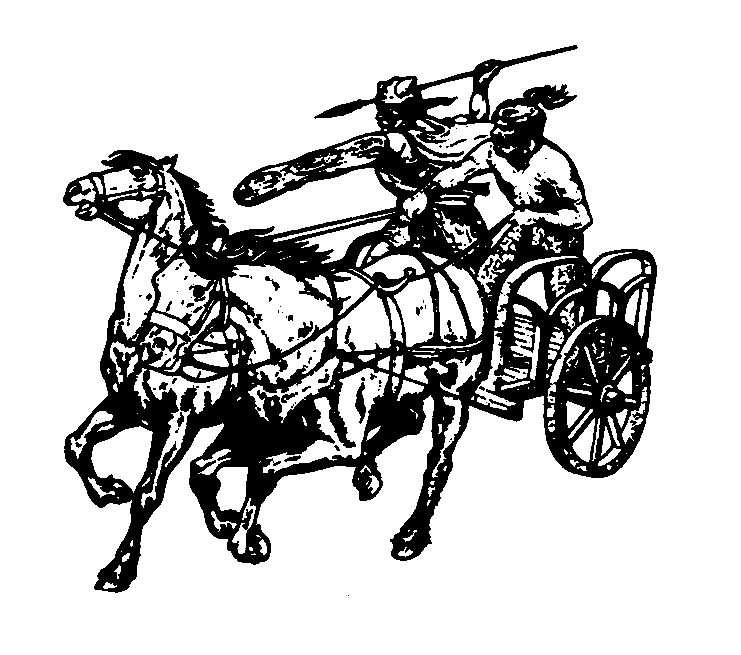
History records; At a later period, the Sarmatians invaded Gaul from the Rhine and Switzerland and drove out the Picts. The name "Celt" does not appear in the fragmentary surviving history of ancient Britain under that exact spelling, it, nevertheless, is represented in its dialectic variant of "Caled" and "Culdees," coincidently the title of the Pictish mission of Columba.
Later, Scotland was referred to as "Albann." In Celtic, Al or Alba means high, whereas "Inn" means large island. The Pictish and later Scottish kings referred to themselves as "Kings of Alba" up until the Norman usurpation of the Scottish throne after MacBeth.
As for the inhabitants, the Romans first called them "Caledonians," then "Picti." Pict referred to the habit of the Picts to paint themselves in times of battle to present a more fearsome image to their enemies. When the Romans first ventured to Briton, this painting habit was also widespread amongst the more southern Celts but as they became domiciled into the Roman culture, this cultural activity was extinguished. It remained prevalent in the north. The term no doubt means "painted people" in Latin. Romans reported the Picts called themselves "Kaltis". When the Picts became Christians, they adopted the Roman term "Pict."
![]()
The Scots, on the other hand, were a branch of the Irish Celts or Gaels. Ireland was divided between the earlier Cruithne (Picts, who migrated from Scotland around 200AD) and later arriving Goidels (Gaels), who were constantly at each others' throats. As Ireland never experienced a Roman invasion, it was a safe haven for raiders who plundered Roman provinces in England and Wales.
All Celts in western continental Europe were subdued by the Romans. However, the Irish branch maintained their cultural development free of the Roman yoke. After the Romans left Britain in about AD453, the Romanized (subdued) Gaels of England became easy targets for the fierce Scotic sea raiders. Scotic is related to the term Scythic and was pronounced the same in some areas of Britain. It is an interesting observation that the German word for both Scottish and Scythian is "Scutten", as the 6th century Saxon invaders of Alba spoke a form of lower German.
Recent dna tests have proven the Scots are closely related to the Berbers of North Africa, whose own ancestry is still also unknown. It is theorized that the heartland of the Celts was transalpine area in what is now Austria in the forth and fifth centuries B.C., when they achieved their greatest prosperity and expansion across Europe. They subjugated all those before them from Spain to the eastern Steppes, and certainly enjoyed the more temperate climate of western Europe, compared to the more severe climate of their Asiatic fatherland.They pillaged Rome, invaded Persia and Macedonia, and
developed contacts with Greeks, and have been: officially recorded by many
distinguished historians as having originated from westward flowing
Scythians, either through merchants or entire clans fleeing the marauding
Sarmatians, themselves an eastern fringe element of the Scythian culture.
THE SCYTHIANS EMERGE
ON THE STEPPES OF EASTERN EUROPE
Arriving with dust and thunder, fierce horsemen from the east
burst upon the European steppe around 700 BC. Invincible for four centuries, these
proud marauders grew rich on the dividends of conquest, decking even their horses with
gold. Then, mysteriously, they vanished, leaving only tales of their courage and
cruelty - and imposing tombs lavishly provisioned for eternity.
These were the Scythians In their time, they were invincible.

Migrating from eastern Asia, the Scythians were masters of the steppe for 400 years. They plundered their way across Asia until they settled in the area north of the Black Sea. Their empire reached from the Danube east across Ukraine all the way to the Don River and the Caucasus Mountains.
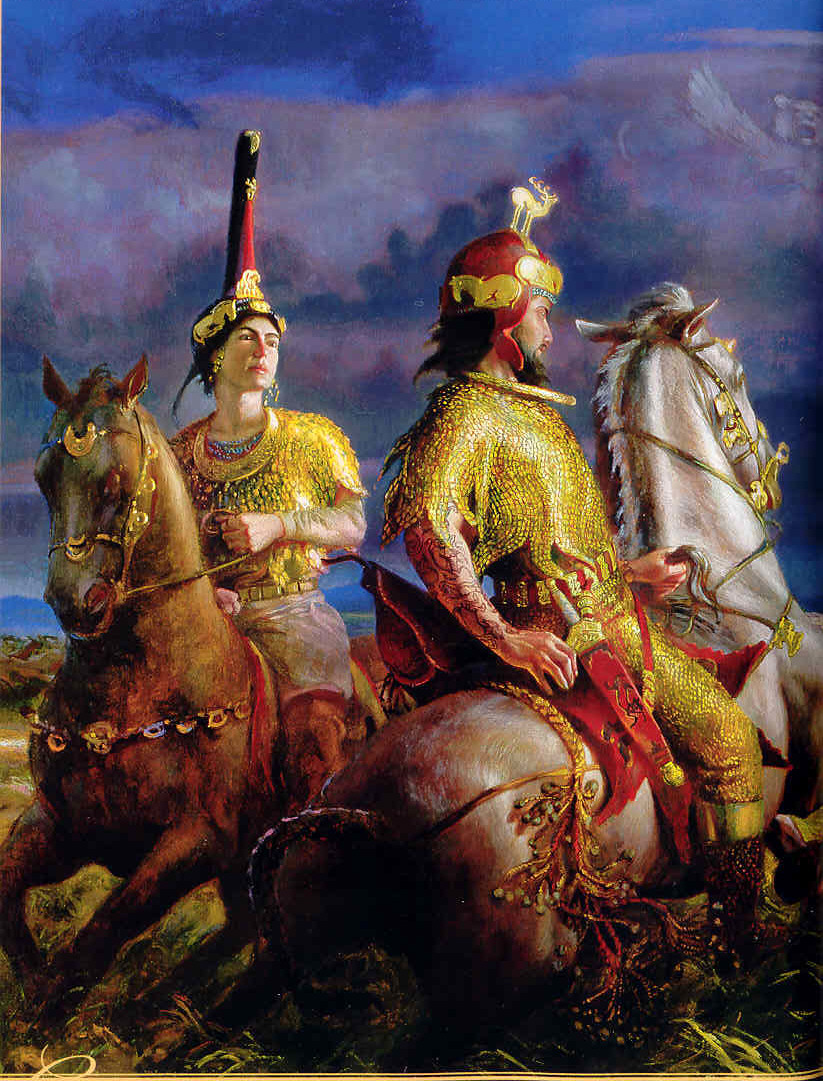
They introduced Europe to oriental
advances in horse equipment and influenced the emerging Celts in many ways not
yet understood or appreciated. They were a pastoral people, not inclined
to establish large urban areas. This feature alone affected the Celts so
much that they too developed into a self sufficient pastoral/ agricultural
culture.
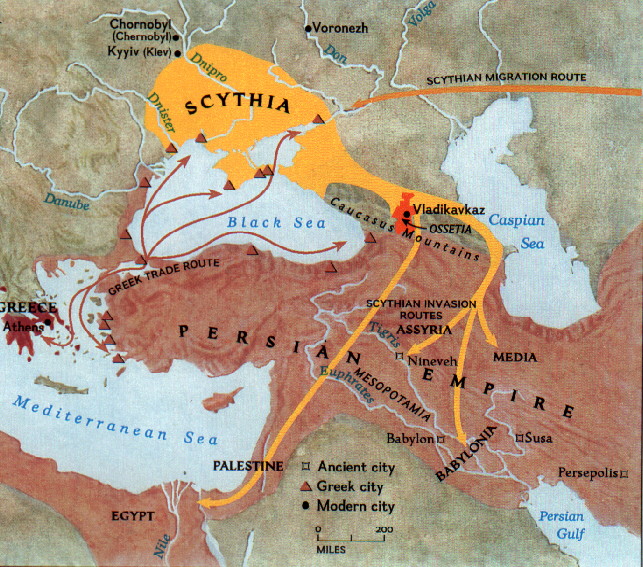
The Scythians sold cereals grown by their sedentary non-equestrian subjects to the Greek merchants who had set up shop in strategic locations around the Black Sea. They soon became the prime source of grains for the Greek city states of the Adriatic. We know that in the fourth century BC, the Sarmatians, a later-emerging branch of the Scythian people encroached on the eastern Scythian lands.
It is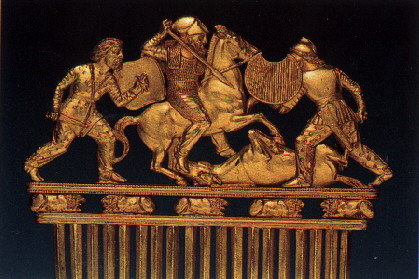 suggested that in the west, Scythians warred with
Macedonians. Historians disagree why their Empire suddenly collapsed, it is known that for 100 years after they
disappeared, their heartland was devoid
of any human occupation. It may have been due to a severe climatic change, severe drought,
over-grazing, or simply an implosion from within.
suggested that in the west, Scythians warred with
Macedonians. Historians disagree why their Empire suddenly collapsed, it is known that for 100 years after they
disappeared, their heartland was devoid
of any human occupation. It may have been due to a severe climatic change, severe drought,
over-grazing, or simply an implosion from within.
Notwithstanding, many of the present day peoples of the Caucasus identify with the Scythians, and maintain many of those ancient tales and myths, also referred to by early Greek historians, such as Jason and the Golden fleece. (It is recorded in both their histories that Jason took a Scythian woman as his wife.)
The Greek historian Strabo, wrote that, at the sunset of their empire, some Scythians migrated to the mouth of the Danube and dispersed with other peoples in that vicinity, which would have been the coincidentally emerging Celts.
![]()
Claims of Ossetians to have been the founding race of Britain
Note: This section is written from the Ossetian viewpoint of history-
Hundreds of years ago, Ossetians (Sarmatians) roamed all over Western Europe, from the Caucasus to Scotland. The folk memories of these wanderings have lingered down the centuries, so that it can be hard to tell where myth ends and history begins.
When the nights draw in in the high Caucasus, when the flocks are gathered in
the shadow of the ancient stone towers that dot the wooded hillsides, and there
is no sound outside but the chattering of the fast streams that run down from
Ossetia towards Georgia, there is nothing the people like better than to settle
down on the settee to watch an old DVD of Braveheart.
Centuries ago, possibly during the great migrations of the Dark Ages, some of their ancestors went down from the Caucasus and set sail through the Black Sea, the Mediterranean, the Atlantic, and arrived eventually in a landscape they recognized: Caledonia.
In fact, though, they did not just occupy Scotland. They occupied the whole of Western Europe on their fast horses, spreading the chivalrous respect for women that is originally an Ossetian concept.And how do we know they reached Britain? Easy: place names. London, In Ossetian, London means "standing water". Belfast, in Ossetian, means "broken spade". (King) Arthur in Ossetian means "solar fire". Orleans in France is "stopping place", because the Ossetians stopped there.
Ossetian children know all about their forefathers' wanderings around Europe and how eventually their territory diminished again to those two little pockets on either side of the great Caucasian watershed.
But the Ossetians, in their glory days of continental mastery, were not known by that name. They were previously called Sarmatians, and sometimes Alans. Every third Ossetian you meet now seems to be called Alan, and the north Ossetian republic, within Russia, is officially "Alania".
Author's note:
The above may be a case of popular Ossetian folk-lure, but there certainly was a connection between the Sarmatians and the early Celts. It was verified by the horse gear of the Celts which was definitely of eastern origin (Scythian/Sarmatian), not western European nor Mediterranean. There are many other Scythian/Sarmatian influences on Celtic/Pict culture, which are explained in this chapter.
Alan was a popular Cornish/Breton name, meaning "rock".
![]()
CELTS ARISE IN THE WEST
The oldest surviving references to the Celts are by Hecataeus and Herodotus, writing in the fifth century BC. Therein, the Celts were reported to have been established in southern France and around Styria in Austria. In 390 BC, the Celtic Gauls of present day France invaded Etruscan territory and sacked Rome. Three Celtic Tribes, called the Galati invaded Asia Minor and settled there. Another tribe invaded Macedonia. Contacts were made with the Scythians, Persians, Greeks and Romans. All these contacts resulted in advances in Celtic culture and sophistication.
Linguistic similarities between Gaulish (early Celt) and Latin (the parent race of the Romans) exist that prove the Celts and the Romans were the same people 60 generations before the time of Caesar.
![]()
PICTS
Flourish in "Alba"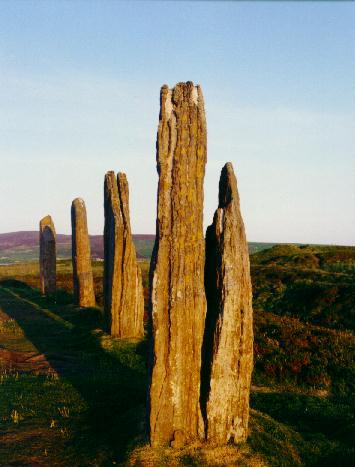
They are recorded to have reached Scotland by the first millennium BC, and chose the best areas for themselves. They called themselves "Kaldis" or "Kaltis." (The later British Celts had to take second best.) They absorbed the earlier tribesmen who were known as Orcades (who were definitely Celtic), and soon dominated the northern half of Scotland. The first to record their existence in Alba were sea-faring Greek merchant, who called them "Albiones" (pale-skinned ones).
When the Romans ventured into their domain, these warrior people were called "Caledonii", then "Picti" (painted or tattooed ones.) They were well organized, fierce warriors, and had several unique characteristics which differentiated them from other Celts, so some historians have not considered them Celts at all.
Bedes reported they recorded their family genealogies along their female lines, similar to the Scythians. They also included female warriors in their standing armies as did the Scythians, but not the Scottish or Germanic peoples. They were not as quarrelsome amongst themselves as were the Scoti. They painted their bodies blue for battle, as was the ancient custom of the Celts. (This practice had died out in the more central areas of Celtic civilization.) They constructed huge hill forts of timber and stone. Their language was not identical with other Celts and, some scholars believe that the Picts were not Celts at all..
![]() Relief's
of
Pictish warriors on Orkney gravestones have a decidedly 'Assyrian' appearance.
Relief's
of
Pictish warriors on Orkney gravestones have a decidedly 'Assyrian' appearance.
![]() Celtic art drew its inspiration from Scythia, especially about
animal representation; i.e. Stylized beasts, abstract geometric decorations.
Celtic art drew its inspiration from Scythia, especially about
animal representation; i.e. Stylized beasts, abstract geometric decorations.
![]() The Pictish wood-built burial chamber
under a barrow was similar to that of the Scythians.
The Pictish wood-built burial chamber
under a barrow was similar to that of the Scythians.
![]() After the Scythians were overwhelmed by
the nomadic Sarmatians, many migrated into Hallstatt (early Celtic) territory in Styria
in present day Austria.
After the Scythians were overwhelmed by
the nomadic Sarmatians, many migrated into Hallstatt (early Celtic) territory in Styria
in present day Austria.
![]() Both Scythians and Picts had an
extreme equestrian culture, (more so than other Celtic tribes.)
Both Scythians and Picts had an
extreme equestrian culture, (more so than other Celtic tribes.)
![]() Trousers and woolen
cloaks were
worn by Picts and other Celts, which were especially convenient when riding horses.
They were not derived from the Mediterranean nor from temperate Europe. They
were obviously from horsemen of the cold eastern steppes, probably the Scythians.
Trousers and woolen
cloaks were
worn by Picts and other Celts, which were especially convenient when riding horses.
They were not derived from the Mediterranean nor from temperate Europe. They
were obviously from horsemen of the cold eastern steppes, probably the Scythians.
![]() Both Pict and Scythian armies used
women warriors, other Celts did not.
Both Pict and Scythian armies used
women warriors, other Celts did not.
![]() Celtic, and Scythian societies
were agricultural-pastoral as each tribe was engaged in its own food production.
Therefore no large urban centres were realized.
Celtic, and Scythian societies
were agricultural-pastoral as each tribe was engaged in its own food production.
Therefore no large urban centres were realized.
![]() The Celts achieved a standard in
arts and crafts unparalleled amongst the ancient inhabitants of trans/Alpine Europe,
rivaled only by their Eurasiatic neighbours and
mentors, the Scythians.
The Celts achieved a standard in
arts and crafts unparalleled amongst the ancient inhabitants of trans/Alpine Europe,
rivaled only by their Eurasiatic neighbours and
mentors, the Scythians.
![]() At about 700BC, there appeared in
the vicinities of Celtic Hungary, Bavaria, and Austria, bronze horse-bits, and bridle mounts,
which were identical to types found in Scythia.
At about 700BC, there appeared in
the vicinities of Celtic Hungary, Bavaria, and Austria, bronze horse-bits, and bridle mounts,
which were identical to types found in Scythia.
![]() Who were these early Hallstatt
Iron age Chieftains? Their horse-gear is an elaboration of their predecessors from
the east.
Who were these early Hallstatt
Iron age Chieftains? Their horse-gear is an elaboration of their predecessors from
the east.
(quote from 'The Celts" by T.G.E. Powell).
![]()
Pict Society
A great Pict King, Onnist, was fighting the Saxons, who were encroaching on Pict territory, when he had a dream of Saint Andrew bearing his cross in a saltern manner against a blue sky. The next day he beat the Saxons in a mighty battle and in gratitude proclaimed the Saltern cross (white on a blue background) as his national banner. It still is the national flag of Scotland.
Similarly, the "Alps" in Europe were originally named by the Kelts. In today's English, the term "Alpine" is synonymous to "mountainous".
![]()
Enter the Scots
The 'Scoti' ventured across the north Irish sea to Argyll in the AD400s and called it "Dalriada" after their Royal House of "Dal Riata" in Ulster.
They were afterwards referred to derisively by the English as "Irish" for over one thousand years.) This marked the first time that Gaelic was spoken in what is now Scotland. The Picts were already established throughout northern Scotland and were not amused with these latecomers. For the next 400 years, Picts and Scots intermittently mingled and fought it out.
Scottish kings arose in Dalriada where they existed with the tolerance of local Pictish Governors. When threatened by outside forces, the Scots and Picts had no qualms re co-operating to beat off a common foe.
The Picts were better organized, more unified, and had a more powerful army. The Scots, on the other hand, were unruly, untrustworthy, cunning, but fierce fighters. When the 'heathen' Norse began pillaging northern Scotland, they hit the Picts harder as they had populated the north, and the western & northern islands, which were the prime targets of Viking plunder.
The Picts outnumbered the Scots and left to their own devices would have
eliminated them. However, devastated by the Giant Norse raiders, the Picts became
susceptible to infiltration by the Scots.
This resulted in many intermarriages and a blurring of racial lines. In a Scot/Pict
marriage, the Pict line went on through the mother and the Scot line was carried on down
through the males. In this way, the Picts were eventually 'married' out of
existence, as official government records were patriarchal, the wife
considered property of the husband.
![]()
The Role of the Britons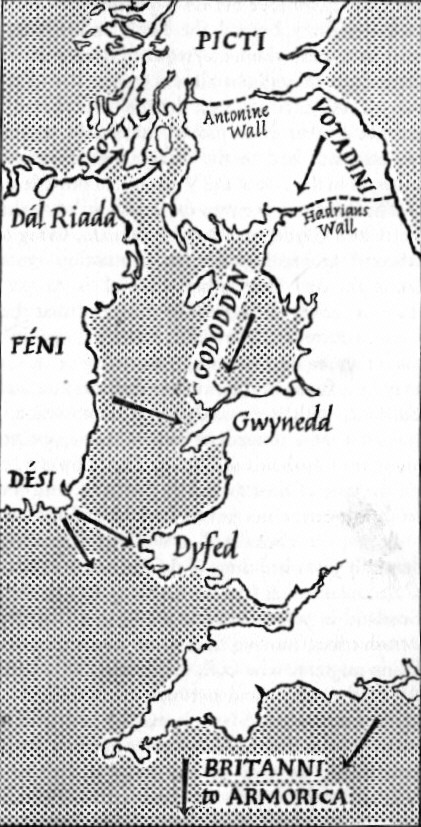
The Romans had developed an effective way of dealing with P-Celts after their horrific wars with the Gauls on the European continent. The "Britons" of southern Caledonia proved no exception, and the Romans eventually used them as a buffer to keep the Picts at bay.
Despite this arrangement, the Antonnine Wall was abandoned as a line to far, and a retreat was ordered back to the Hadrian Wall, leaving the Britons exposed to Pict reprisals. The Britons continued for a time to be Roman allies, but could not contain the Picts in their thirst for revenge on the Romans.
In this degenerating situation, some Britons were susceptible to an ingenious Roman manoeuvre.
The Romans had earlier developed an effective countermeasure to external threats to their empire, by transferring loyal subjects of one area to a threatened area to defend it from assault. They implemented this extraordinary measure about 200 AD by the wholesale voluntary movement of loyal Britons in southern Scotland, called the "Goddodin", to the territory of the "Gwynedd", modern "Wales."
This mass movement created a new elite in Gwynedd, since the previous Druids were ruthlessly annihilated by the Romans as part of their strategy to break the back of any possible future insurrection. This favoured new elite implanted their unique Briton language on the "Welsh", which remains in a somewhat modified version today.
![]()
Picts Win The Battles But - Lose The War
![]()
During the AD800s, the Picts constituted about 90% of the population
of northern Scotland, (the Scots only about 10%). However they were
constantly harried 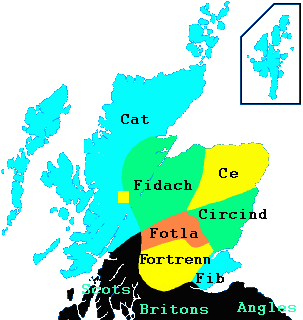 and were under heavy pressure by Norse in
the north, Scots in the south-west, and by Germanic tribes of Angles in the south.
In
battle after battle, they succeeded in repulsing all antagonists.
and were under heavy pressure by Norse in
the north, Scots in the south-west, and by Germanic tribes of Angles in the south.
In
battle after battle, they succeeded in repulsing all antagonists.
This land was defended many times after Rome's departure. The Picts fought invasions by the Irish-Gaelic Scots in the west, the Welsh Britons in the southwest, and German Saxons in the southeast, and the sea borne Norse and Danish Vikings in the north, northwest, and northeast.
They sometimes lost great battles and huge chunks of land, only to regain them later through perseverance in the vicious warfare of the dark ages.
In the 7th century, Scots pushed their frontier far north, and
a victorious Gaelic army came within a half-day march of the Pict capital of Inverness
before it was crushed. In the south, the Saxons marched their Teutonic armies north
and held Pict lands for 30 years before they were butchered and sent fleeing south by an
avenging Pict army.
However, in AD837, the Picts suffered their most devastating military defeat - by the Norsemen. They lost their King and most of their leaders. This one event marked the beginning of the end of Pict domination of Alban.
Their western and northern territories, including their island empire of the Hebridies, Orkneys, Shetland, and Faroes gone, they lost control of their own people and fell into a long period of civil wars and anarchy, and became fatally infiltrated by the Scots. As in a dying fire, they flickered back to life briefly through the 11 year rule of the last Pictish King of Alba, Grig the Great, Conqueror of all Alba, Hibernia (Ireland), Anglia (Lothian), and Northumbria. But by AD1000, their culture was gone, replaced through assimilation by the Scots, much of it through inter-marriage, from slave raids by the Vikings, and the rest through a state-sponsored genocide, much similar to the fate later designated for the Clan Gregor.
Historical records of that time tell of large Viking centres in Ireland such as Dublin and Belfast, that owed their existence to the trade in vast numbers of Pict slaves taken from Scotland, who, due to their white skin, knowledge of Latin, and their long history of Christianization, were in great demand by the Romans.
Derided inaccurately by many historians as "aboriginals", they established a hierarchal society, an island Empire, defeated the best Roman Legions, and sent them scurrying south behind "Hadrian's Wall", fought off successive invaders from all corners of their country, and traded extensively with mainland Europe.
Thus a sad end came to a magnificent people (and their beloved ponies) on the fringe of north-western Europe, a people who had become a shining light of Christianity, sent missionaries into a hostile northern Europe for 500 years, and helped prepare the groundwork for the Lutheran reformation.
To read the story of the last Pictish Kings, visit: